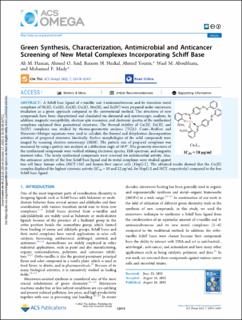| dc.contributor.author | Hassan, Ali M. | |
| dc.contributor.author | Said, Ahmed O. | |
| dc.contributor.author | Heakal, Bassem H. | |
| dc.contributor.author | Younis, Ahmed | |
| dc.contributor.author | Aboulthana, Wael M. | |
| dc.contributor.author | Mady, Mohamed Fawzy Hamed Attia | |
| dc.date.accessioned | 2023-02-17T14:14:57Z | |
| dc.date.available | 2023-02-17T14:14:57Z | |
| dc.date.created | 2022-10-15T14:51:07Z | |
| dc.date.issued | 2022 | |
| dc.identifier.citation | Hassan, A. M., Said, A. O., Heakal, B. H., Younis, A., Aboulthana, W. M., & Mady, M. F. (2022). Green Synthesis, Characterization, Antimicrobial and Anticancer Screening of New Metal Complexes Incorporating Schiff Base. ACS omega, 7(36), 32418-32431. | en_US |
| dc.identifier.issn | 2470-1343 | |
| dc.identifier.uri | https://hdl.handle.net/11250/3052032 | |
| dc.description.abstract | A Schiff base ligand of o-vanillin and 4-aminoazobenzene and its transition metal complexes of Ni(II), Co(II), Zn(II), Cu(II), Mn(II), and Zr(IV) were prepared under microwave irradiation as a green approach compared to the conventional method. The structures of new compounds have been characterized and elucidated via elemental and spectroscopic analyses. In addition, magnetic susceptibility, electron spin resonance, and electronic spectra of the synthesized complexes explained their geometrical structures. The thermal stability of Cu(II), Zn(II), and Zr(IV) complexes was studied by thermo-gravimetric analyses (TGA). Coats–Redfern and Horowitz–Metzger equations were used to calculate the thermal and dehydration decomposition activities of proposed structures kinetically. Surface morphologies of the solid compounds were imaged by scanning electron microscopy (SEM). The particle size of prepared complexes was measured by using a particle size analyzer at a diffraction angle of 10.9°. The geometry structures of the synthesized compounds were verified utilizing electronic spectra, ESR spectrum, and magnetic moment value. The newly synthesized compounds were screened for antimicrobial activity. Also, the anticancer activity of the free Schiff base ligand and its metal complexes were studied against two cell lines: human colon (HCT-116) and human liver cancer cells (HepG-2). The obtained results showed that the Cu(II) complex displayed the highest cytotoxic activity (IC50 = 18 and 22 μg/mL for HepG-2 and HCT, respectively) compared to the free Schiff base ligand. | en_US |
| dc.language.iso | eng | en_US |
| dc.publisher | American Chemical Society | en_US |
| dc.rights | Navngivelse 4.0 Internasjonal | * |
| dc.rights.uri | http://creativecommons.org/licenses/by/4.0/deed.no | * |
| dc.title | Green Synthesis, Characterization, Antimicrobial and Anticancer Screening of New Metal Complexes Incorporating Schiff Base | en_US |
| dc.title.alternative | Green Synthesis, Characterization, Antimicrobial and Anticancer Screening of New Metal Complexes Incorporating Schiff Base | en_US |
| dc.type | Peer reviewed | en_US |
| dc.type | Journal article | en_US |
| dc.description.version | publishedVersion | en_US |
| dc.rights.holder | The authors | en_US |
| dc.subject.nsi | VDP::Teknologi: 500 | en_US |
| dc.source.journal | ACS Omega | en_US |
| dc.identifier.doi | 10.1021/acsomega.2c03911 | |
| dc.identifier.cristin | 2061659 | |
| cristin.ispublished | true | |
| cristin.fulltext | original | |
| cristin.qualitycode | 1 | |

